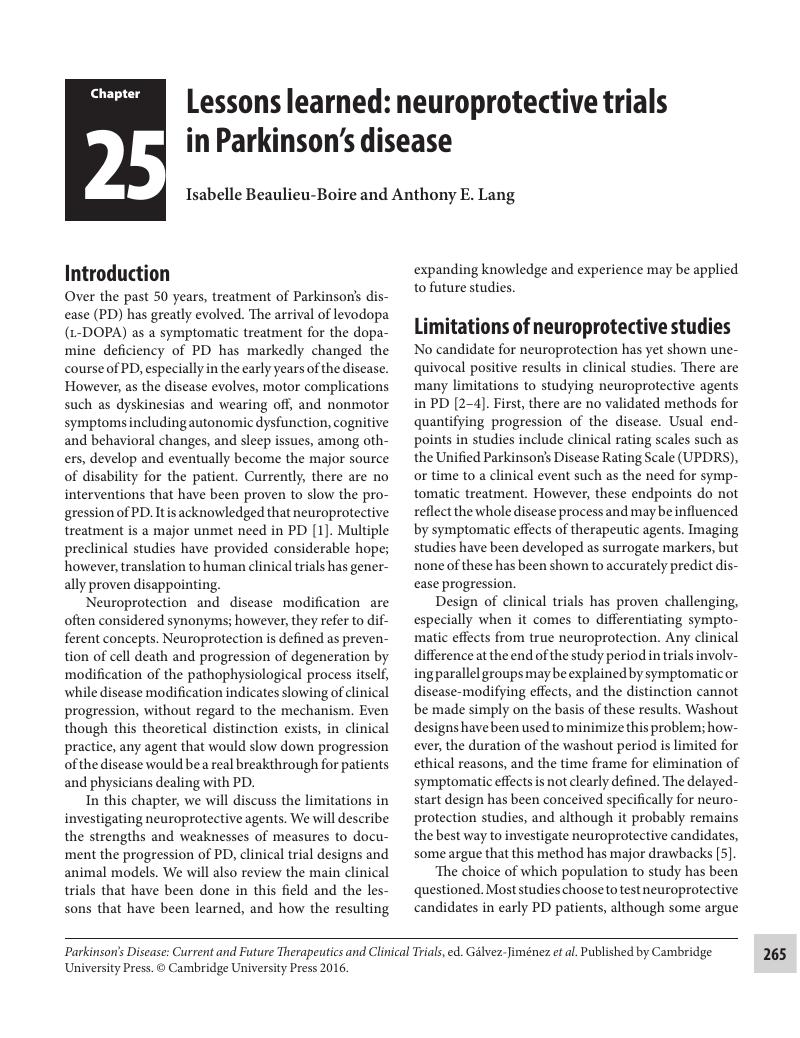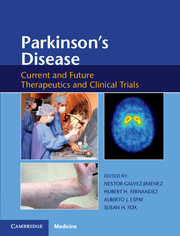Book contents
- Parkinson's DiseaseCurrent and Future Therapeutics and Clinical Trials
- Parkinson's Disease
- Copyright page
- Contents
- Contributors
- Book part
- Section I The Pharmacological Basis for Parkinson's Disease Treatment
- Section II Management of Nonmotor Symptoms of Parkinson's Disease
- Section III Surgical Management of Parkinson's Disease
- Section IV Clinical Trials in Parkinson's Diease: Lessons, Controversies and Challenges
- Chapter 22 Rating scales and clinical outcome measures in the evaluation of patients with Parkinson's disease
- Chapter 23 Functional imaging markers as outcome measures in clinical trials for Parkinson's disease
- Chapter 24 Cerebrospinal fluid and blood biomarkers as outcome measures in clinical trials for Parkinson's disease
- Chapter 25 Lessons learned: neuroprotective trials in Parkinson's disease
- Chapter 26 Lessons learned: symptomatic trials in early Parkinson's disease
- Chapter 27 Controversy: globus pallidus internus versus subthalamic nucleus deep-brain stimulation in the management of Parkinson's disease
- Chapter 28 Controversy: ablative surgery vs deep-brain stimulation in the management of Parkinson's disease
- Chapter 29 Controversy: midstage vs advanced-stage deep-brain stimulation in the management of Parkinson's disease
- Chapter 30 Lessons and challenges of trials for cognitive and behavioral complications of Parkinson's disease
- Chapter 31 Lessons and challenges of trials for other nonmotor complications of Parkinson's disease
- Chapter 32 Lessons and challenges of trials involving ancillary therapies for the management of Parkinson's disease
- Index
- References
Chapter 25 - Lessons learned: neuroprotective trials in Parkinson's disease
from Section IV - Clinical Trials in Parkinson's Diease: Lessons, Controversies and Challenges
Published online by Cambridge University Press: 05 March 2016
- Parkinson's DiseaseCurrent and Future Therapeutics and Clinical Trials
- Parkinson's Disease
- Copyright page
- Contents
- Contributors
- Book part
- Section I The Pharmacological Basis for Parkinson's Disease Treatment
- Section II Management of Nonmotor Symptoms of Parkinson's Disease
- Section III Surgical Management of Parkinson's Disease
- Section IV Clinical Trials in Parkinson's Diease: Lessons, Controversies and Challenges
- Chapter 22 Rating scales and clinical outcome measures in the evaluation of patients with Parkinson's disease
- Chapter 23 Functional imaging markers as outcome measures in clinical trials for Parkinson's disease
- Chapter 24 Cerebrospinal fluid and blood biomarkers as outcome measures in clinical trials for Parkinson's disease
- Chapter 25 Lessons learned: neuroprotective trials in Parkinson's disease
- Chapter 26 Lessons learned: symptomatic trials in early Parkinson's disease
- Chapter 27 Controversy: globus pallidus internus versus subthalamic nucleus deep-brain stimulation in the management of Parkinson's disease
- Chapter 28 Controversy: ablative surgery vs deep-brain stimulation in the management of Parkinson's disease
- Chapter 29 Controversy: midstage vs advanced-stage deep-brain stimulation in the management of Parkinson's disease
- Chapter 30 Lessons and challenges of trials for cognitive and behavioral complications of Parkinson's disease
- Chapter 31 Lessons and challenges of trials for other nonmotor complications of Parkinson's disease
- Chapter 32 Lessons and challenges of trials involving ancillary therapies for the management of Parkinson's disease
- Index
- References
Summary

- Type
- Chapter
- Information
- Parkinson's DiseaseCurrent and Future Therapeutics and Clinical Trials, pp. 265 - 279Publisher: Cambridge University PressPrint publication year: 2016

